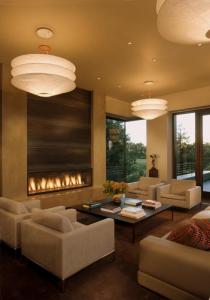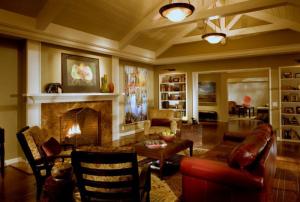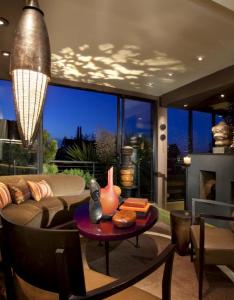Lighting

Randall Whitehead is an internationally known architectural lighting designer based in San Francisco. He is not only a prolific author, but an enlightening and humorous speaker on the world of design as well. His work has appeared in Architectural Digest, Art & Antiques, House Beautiful, Kiplinger’s, Horticulture Magazine, Designs for Living, Metropolitan Home, The Journal of Light Construction, Better Homes & Gardens, and many more. Randall appears regularly as a guest expert on the Discovery Channel, CNN, HGTV, and Martha Stewart Living Radio. He also writes a monthly column called “The Last Word in Lighting” for Residential Lighting Magazine (www.residentiallighting.com), answering homeowners’ and designers’ questions on lighting. You can check out his blog at www.lightmakesright.com and follow him on twitter: @RDWlighting. Randall has written seven books on lighting, including Residential Lighting, A Guide to Beautiful and Sustainable Design, which is a reference book for home and garden lighting.
The living room might just be the most used room in the house, but many homeowners are in the dark about how to make the best use of light in the space. We asked lighting designer Randall Whitehead to tell us how.
Q. What considerations should be taken into account when lighting a living room?

Caption: This living room has very high ceilings. Four Ingo Mauer Flotation pendants are used to create a more human scale to the space, while providing both a decorative element and wonderful overall glow of ambient illumination. Each fixture is rated for five 100-watt lamps. We used five 24-watt dimmable compact fluorescent lamps instead in a warm 2700 Kelvin color temperature. Recessed adjustable fixtures highlight the façade of the fireplace as well as the tabletop and sculpture. After the sun has set, exterior lighting focused on the trees outside keeps the windows from becoming black mirrors at night
Photography: Dennis Anderson (www.bluewaterpictures.com)
Interior Design: Nicki West
Lighting Design: Randall Whitehead (www.randallwhitehead.com)
A. When I was growing up, the living room was always off-limits to the family. It was only there for when guests came over. There was this invisible rope that kept us out of there. As homes are being designed with more open floor plans, the living room/great room, kitchen, and dining area are becoming part of one connected space. This means that people are finally taking advantage of what was traditionally an underused space. Living rooms, like all rooms in the house, need to have various types of lighting to create a flexible and inviting environment. The technique is called light layering. This is when we use four different types of lighting: task, decorative, accent, and ambient to create a cohesive design. Each of these has a different function:
- Task lighting is a light by which you do work. This can be the lighting installed under the overhead cabinets in the kitchen, inside the closet, or on either side of the mirror for applying makeup and shaving.
- Decorative lighting is what we all grew up with and know. This includes the chandelier over the dining room table or in the entry, as well as table lamps and floor lamps. If these are too bright, then they visually overpower space. We want to create the illusion that this is where the light is coming from, while in reality it is hidden light sources that are doing most of the work. I like to think of decorative lighting as architectural jewelry.
- Accent lighting is used to highlight objects in space, such as art, sculpture, tabletops, and plantings. It adds dimension and drama to a space, but if it is the only source of illumination then you create what is called the museum effect, where what you own appears to be more important than family and friends.
- Ambient lighting is the most important element, yet it is often left out of the job completely. This is indirect lighting that is bounced off of the ceiling to create a warm and inviting environment, while softening the shadows on people’s faces. Like the other types of lighting, if used by itself it creates what I call the cloudy-day effect, where everything is illuminated in a flat, even light.
It is when you successfully layer these different types of lighting together that you create drama for the living room. Now you don’t want it to be dramatic all the time, there are occasions when you want usable light for working or preparing meals. A really good lighting design is flexible, offering various levels of illumination to meet a particular need.
Q. What are the best options that exist on the market today in terms of efficiency?

Caption: In a more traditional setting, light layering still applies. Along the ridge beam there are low-voltage track lights, using LED MR16 lamps providing accent light for the art, while the alabaster pendants offer both a decorative element as well as ambient light for the space. These fixtures use three 24-watt dimmable compact fluorescent lamps. Additionally there are runs of a LED tape lights mounted on top of the beams that run parallel to the floor that help project more light towards the ceiling and highligh the architectural detailing. A pair of picture lights, mounted above the two bookcases, softly wash the books and art objects with illumination.
Photography: Dennis Anderson (www.bluewaterpictures.com)
Interior Design: Nancy Satterberg (www.satterbergdesign.com)
Lighting Design: Randall Whitehead (www.randallwhitehead.com)
A. In California, we have been doing eco-friendly lighting for so long that for us it is second nature. We’ve had building codes in place for more than 20 years that require the use of energy-efficient light sources. For all this time the lighting design community has been pushing the manufacturers to create fixtures that are not only energy-efficient but alluring as well. Many of the less expensive LED (light-emitting diodes) and fluorescent products on the market are not very complimentary to skin tones. For more than a hundred years people have been used to the warm color of incandescent light. As these alternative light sources continue to improve, they are getting closer and closer to the inviting tones that homeowners desire. Homeowners would greatly benefit from understanding the various colors of light that are being offered. This is normally referred to as color temperature(measured in degrees of Kelvin). Simple rule of thumb is that the higher the color temperature is, the cooler the color of the light that is produced, and the lower color temperature is warmer. One of the drawbacks of LEDs and compact fluorescents has been that they do not become warmer in color when dimmed. People want that. It reminds us of fireplaces and candlelight. LED manufacturers are now beginning to offer bulbs and fixtures in the color temperature of dimmed incandescent, or bulbs and fixtures that actually give the illusion of getting warmer when dimmed. This effect is created by using both cool-colored and warm-colored diodes within their products that turn off in sequence, so that as the light level is lowered, the illumination becomes more amber. This is a huge step in creating an alternative light source that has the look and feel of incandescent light.
Q. What are some of the common bulb types found in a living room?

Caption: Here is a good example of light layering. The low-voltage track lights using LED MR16 lamps highlight the art, while the wall sconces flanking the fireplace and the large window on the right create the illusion of providing the room’s illumination. The real fill light comes from four opaque indirect wall sconces mounted on the high wall that project light onto the wood ceiling and provide a comfortable level of ambient light. The floor lamps offer good reading light.
Photography: Jeff Zaruba (www.jeffzaruba.com)
Interior Design: Turner Martin Design (www.turnermartindesign.com)
Lighting Design: Randall Whitehead (www.randallwhitehead.com)
A. Right now there is a very big market for retrofit lamps (“lamp”is the industry term for light bulb). People are not ready to jump on the integrated component market just yet, so for now they are experimenting with energy-efficient light sources that can screw into their existing fixtures. There are three main categories to choose from: CFLs (compact fluorescent lamps), CCFLs (cold cathode compact fluorescent lamps) and LEDs. CFLs have gotten much better than when they were first introduced, but people do feel negatively towards them from their experiences early on. The better lamps have electronic ballasts that eliminate the buzz. They also come in a variety of color temperatures. Of the three lamp types, these offer the highest lumen output. Many now come in dimmable versions. They do not have full range of dimming but can be dimmed down to 30%. CCFLs are lesser known but they are a particular favorite of mine. The glass tubing that contains the phosphors is much smaller in diameter than standard CFLs, about the diameter of spaghetti. This allows them to fit inside glass envelopes that are the shape of the light bulbs we grew up with, such as household bulbs (known as A-lamps), flame tip bulbs (known as B-10 lamps), and round globe bulbs (known as G-lamps). CCFLs can have a lamp life of 18,000-25,000 hours, as compared to a CFL, which has an average rated lamp life of 10,000 hours. A standard household bulb has an average rated lamp life of 750 hours. The dimmable versions of CCFLs can be dimmed down to 10%. I recommend using these primarily in decorative fixtures were lumen output is not required; the highest wattage equivalent available presently is 60 Watts. LEDs are having a harder time in the retrofit market in terms of offering something that is acceptable to the general public. The reason being is that light-emitting diodes are unidirectional, meaning that they project light in one direction. Household bulbs and fluorescents are omnidirectional, which means that they throw light out evenly in all directions. The lamp manufacturers are working very hard to create LED lamps that throw light evenly in all directions. Some are more successful than others. For now, with a few exceptions, the maximum wattage equivalent they can offer is 60 watts. I do predict that it won’t be long before 75-watt and 100-watt equivalent LED A-lamps will be introduced on the market. There are dimmable versions of LEDs that have the ability to be dimmed down to 5%. I think all of these energy-efficient lamps have a place in the living room, as well as the rest of the house. The trick is to use a color temperature that you are comfortable with and a lumen output that meets your needs.
Q. Can you touch upon some Best Practices for living room lighting, as well as some common pitfalls people run into?
A. Nowadays we want to integrate the living room lighting into the rest of the open plan. We want to make sure that the amount of illumination flows from area to area so that it feels like one large, cohesive space. If there are high ceilings then people may feel overwhelmed by the size of the room. Adding a series of decorative fixtures, hanging from the ceiling, creates a more human scale to the room. These can perform the function of being both decorative as well as ambient if the shade material is opaque or semi-translucent, helping to direct some of the light towards the ceiling.

Caption: Lighting plays a central role in welcoming family and friends into this compact living room space. The first thing you may notice is the pattern of light on the ceiling. This comes from a projector fixture made by Beachside Lighting (www.beachsidelighting.com) which is hidden behind the curve to sofa. This provides ambient light in a rather unique way. Recessed adjustable fixtures using LED MR16s bring focus to the objects on the coffee table as well as the art placed around the room. The hanging fixture off to the left gives the illusion of providing the rooms light, but in reality it is only one 8-watt CCFL lamp. Lighting beyond the floor-to-ceiling windows helps to visually enlarge the room at night.
Photography: Dennis Anderson (www.bluewaterpictures.com)
Interior Design: Turner Martin Design (www.turnermartindesign.com)
Lighting Design: Randall Whitehead (www.randallwhitehead.com)
The general contractor or architect may just do a series of recessed fixtures in a living room. This tends to be very unattractive lighting to be under. Remember when at Halloween you would hold a flashlight under your face to create a scary look? The same thing happens in reverse when you have a person sitting or standing under a recessed fixture. This harsh shadowing makes people look older and more tired than they are. My recommendation is to use recessed adjustable fixtures that can be directed towards art, plants, and tabletops. If you already have recessed fixtures, they can be retrofitted to accept an adjustable trim. The other thing that I see is that people will fill a room with table lamps and floor lamps thinking that this will cover all of their lighting needs. What it does instead is make the room look like a lampshade showroom. Our eyes are attracted to bright sources of illumination. So when people walk in all they see are the lampshades, forcing friends, family, art, and architecture to fall into lesser levels of importance. Floor lamps and table lamps still have a role to play in a good lighting design, they just can’t be the only players.
Q. What are some products you could recommend to consumers?
A. Here are some products that I have tested and used in my own home. (Please note that these companies don’t pay me to recommend them.) CFLs – Maxlite (www.maxlite.com) CCFLs – Litetronics (www.litetronics.com) LED A-lamps, B-10 lamps, and R lamps (reflector bulbs) – Borealis (www.borealis.com) LED MR16 lamps (mini reflector bulbs that fit into low-voltage recessed fixtures and track lights) – Soraa Lighting (www.soraa.com) LED undercabinet task light – Tech Lighting’s Unilume LED (www.techlighting.com)